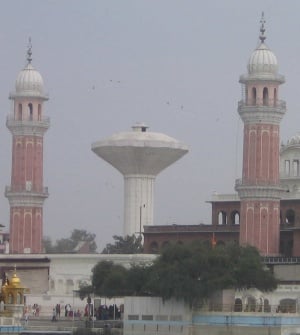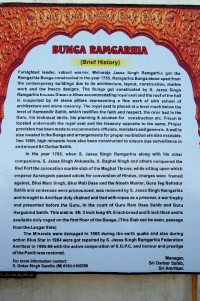Ramgarhia bunga

The history of the Ramgarhia Bunga (Punjabi word for quarters) is inseparable from the history of the Golden Temple because its very existence is dependent on the latter. During the reign of the Mughal Emperors the temple was blown up with gunpowder or destroyed by other means no less then seven times. But each time it was rebuilt by the Sikhs. When it was demolished the last time, and the Sardars of the 12 Misls assembled at the Akal Bunga (situated in the front of the temple) to consult about the reconstruction of the temple it was rightly thought that it would be no use to rebuild the temple unless some of the Khalsa leaders remained in it for its protection against their enemies.
The Bhangi's, the Ahluwalia's and the Ramgarhia's were selected to dwell in the sacred precincts with their forces as the guardians of the temple. They were directed to call on the other Sardars for help in case of any great danger, each of the six great Misls gave also one man to serve in the temple. The present priest (Pujaris) are descendants of those six men. The income of the temple after deducting other expenses is divided and sub divided, and distributed in due proportion among the descendants of the six Pujaris.
The Pujaris had some fixed duty to perform and were called according to their duties, e.g., the man who lighted the lamp was called charagi (charag, lamp in Punjabi) and so on. Their descendants still retain the old designations. The duty of the person given by the Ramgarhia Misl was to perform the ardas (prayer ceremony at start and end of ceremony), his descendants are also called ardasias. The ceremony is thus performed, the ardasia stands respectfully with his face to the Granth and distinctly repeats the name of the ten Gurus in the prescribed manner and then says that such a person has brought such and such a thing as an offer to the Guru, may the Guru purify his soul and grant his prayer.
The Structures
The Ramgarhias rebuilt the old fort Ram Rouni for their forces and named it Ramgarh. They also built a Bunga called Ramgarhia Bunga for their own residence to the east of the temple. Thus the temple was protected on all four sides by these Sikh Sardars. The very structure of this Bunga shows the special purpose for which it was built. The two lofty towers were obviously built to espy the enemy from a distance. The Bunga is the largest of all the mansions. The towers are each three storied and nearly 156 ft. high from the ground. No wood is used anywhere in the construction.
Besides numerous masonry arches, there are 44 marble and red stone pillars (very beautifully ornamented with engraved designs) supporting the roof of the upper storey of the Bunga. The facade is highly decorated with delicately chiselled patterns of unrivalled excellence. Here the ancient Coronation Stone of the Grand Mughals (which Sardar Jassa Singh brought from Delhi) is fixed, having three pillars on each side, the priest every day recites the holy Granth on this historic slab. The dimensions of the stone are 6'-3" X 4'-6" X 9." The length of the frontage of the Bunga is nearly 150 ft.
One can have a very good view of the city from the storeys of the towers, many European visitors come to enjoy the sight and many take photographs of the extensive view below their feet. These towers are visible from many miles, and add to the beauty of the city. When Maharaja Ranjit Singh took possession of the territory of the Misl, the Bunga also went to him. At that time the Bunga, for some reason or another, was only half finished and the towers were not yet domed, possibly because it was the intention of the Sardars to raise them higher.
History
But Ranjit Singh at once ordered that the towers be raised no higher and all the materials and many pillars and pieces of stone and marble very beautifully engraved he sent to Ram Bag (now called Company Gardens) which he was preparing as a pleasure ground. There was such a large stock of building material that after using all that was required for the garden the remainder were stocked and employed afterwards in the preparation of the last bed for the Lion of the Punjab in the Guru Garden where free from the anxieties of the world he sleeps calmly and quietly under the serene shadow of the lofty Ramgarhia towers.
By comparison also many of these pieces are found of the same pattern and sculptured by the same hand. Afterwards the Bunga was given to Sardar Mangal Singh Ramgarhia for his personal services by the Maharaja and from that time the Bunga became the property of Sardar Mangal Singh alone. Since that time the Bunga is used as a place of residence by the male members of the family. A large house, 3 storied and 140 ft. long has been built for the female members of the family in the Katran Ramgarhian. The street in which this house is built is called 'Koocha Sardar Mangal Singh Ramgarhia' and a board is set up there by the Municipality with the above inscription.
The fact that the family has fixed its abode in the proximity of the Bunga with temple is one of the chief causes that enabled the members of this family to manage the affairs of the Golden Temple so well. This family has been connected with the temple from the very beginning, and thus its members know the whole process of its evolution, and the principles required to manage its affairs. The members of this family, besides, consider it a religious duty to look after the shrine. Aye, for this temple their ancestors gladly risked and laid down their lives. It is for these reasons that Sardar Mangal Singh was appointed the President of the managing committee of the temple consisting of all the Sikh Sardars of the Punjab.
Present situation
The Bungas are located in the vicinity of Sri Darbar Sahib, Amritsar. The Ramgarhia Bunga which was built by S. Jassa Singh Ramgarhia in the late 18th Century is the only surviving example of Bunga architecture typology. In the period following its construction it served a dual purpose of housing pilgrims visiting Sri Darbar Sahib and fortifying the area to protect the holy complex from outside invasion. Ramgarhia Bunga consists of three flat-roofed ranges, each of two principal storeys, arranged round three sides of a court-yard and is constructed almost completely of small kiln fired Nanakshahi bricks, set in lime and mud mortar.
The colonnade and the triple arches are of red sandstone. The undersides of the vaults and all the walls were finished internally and externally with lime plaster and lime wash, much of it is decorated with arches. Lower levels of the Bunga are approached by two flights of steps, one from outside and the other from within the courtyard.
Need to renovate
The building has serious issues related to deterioration of its historic built fabric and needs urgent measures for its conservation. Amongst the issues of immediate concern are seepage of water into roofs and walls, structural and material decay, use of incompatible material and inappropriate additions, alterations and repairs carried out over the years, all of which have contributed in one way or the other to its present degraded state. With the intention of protecting and preserving the building, the S.G.P.C. (Shiromani Gurdwara Parbandhak Committee), has approved a plan for its conservation that shall not only check decay but will also include works for its structural strengthening. The project will be carried out under the skilled and expert supervision of Dr. Manjit Singh and Dr. Balwinder Singh from Guru Nanak Dev University, Amritsar and S. Manjinder Singh Gill Art Conservator, S. Ajaideep Singh Jamwal, Conservation Architect, Shri Kumar Menon Material Anaylst, Shri Kunjan Popat, Structural Engineer, all of Heritage Conservation Management Services, Noida (Delhi).
Work to be undertaken
The works being undertaken would focus on curtailing the use of water and prevent its ingress into the fabric of the structure. Infills would be removed and terracing of the roof redone in traditional materials with appropriate drainage. Temporary structures shall be dismantled and ventilation of hitherto enclosed spaces shall be improved. Cement plaster shall be removed from the walls wherever it has been used and shall be replaced with lime plaster. The removal of new brick-cement flooring of the courtyard will help in the relieving of a lot of superimposed load on the vaulted structure below. Major structural cracks shall be stapled by helical bars and grouted.
Lesser vertical cracks in the brick masonry wall will be stitched using thin bricks, similar to the original, and lime mortar. Blocked openings between rooms will be opened to provide for proper cross-ventilation and facilitate drying up process. The cement concrete flooring of all rooms will be removed. Photo documentation would be carried out at all stages before, during and after conservation. The adaptive re-use of the building would subsequently be carefully considered so that the structure is appropriately used as a public place. It needs to the specially mentioned here that the two towers adjacent to the Bunga shall not be touched in any way during the ‘Kar-Sewa’ of Bunga Ramgarhia.
The formal inauguration of ‘Kar-Sewa’ Bunga Ramgarhia was done at a small but impressive ceremony by Sardar Avtar Singh Ji, honorable President S.G.P.C on 17-04-2008.
External links
- sgpc.net Conservation of Ramgarhia Bunga

